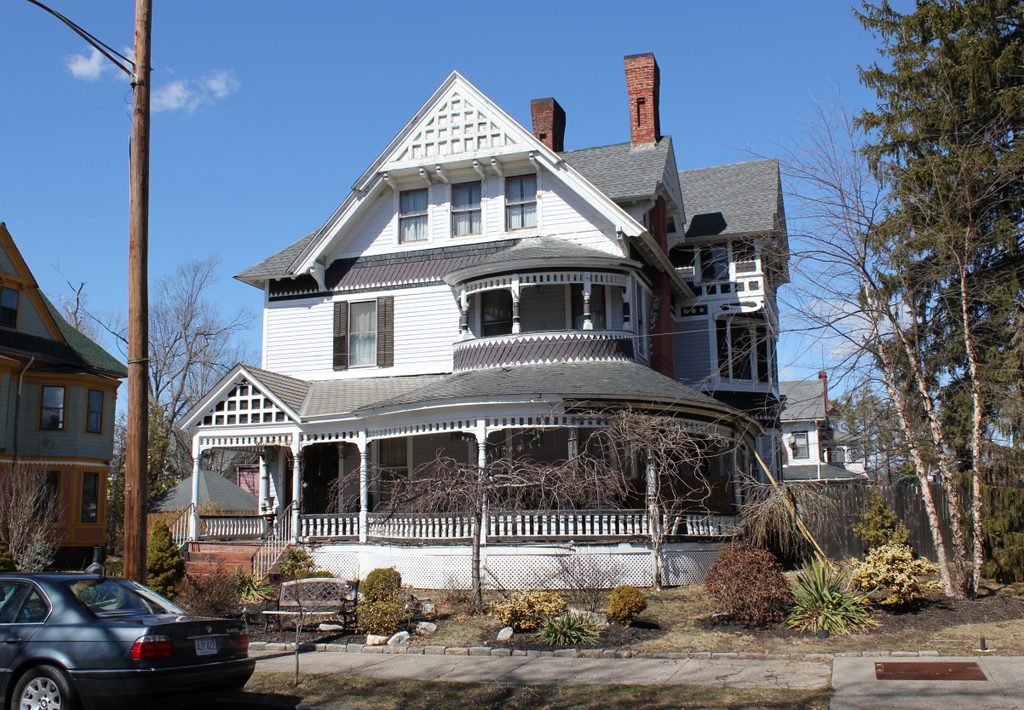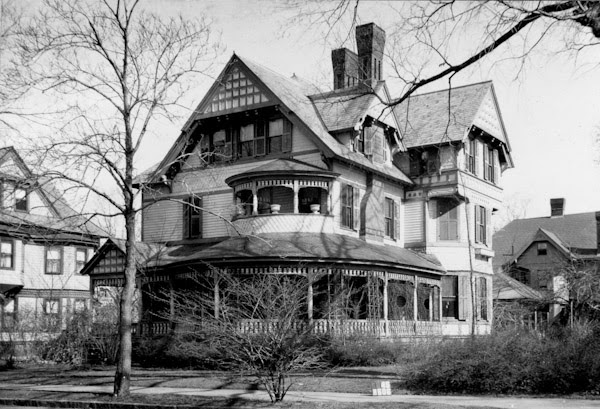The house at 111 Dartmouth Terrace in Springfield, around 1938-1939. Image courtesy of the Springfield Preservation Trust.
The house in 2017:

Many of the houses on Dartmouth Terrace were built in 1888, including this one at the corner of St. James Avenue. It was built for Orlando M. Baker, one of the partners in G. & C. Merriam & Co., the publishing company that later became Merriam-Webster. He was born in New York state in 1832, and moved throughout the country, including working as a school principal in Milwaukee in the 1860s. During this time, he married Abbie Walton, a Milwaukee native, and the couple had a son, Harris. They were living in Springfield by 1880, and in 1882 Orlando joined the Merriam company. He later became treasurer and, in 1904, became president of the famous dictionary publishers. In the meantime, Abbie died in 1896, and the following year Orlando married her younger sister Kate, who was 22 years younger than him. The couple lived here together until his death in 1914.
By 1920, the house was owned by Charles and Jessie Young. Charles was 69 at the time, 15 years older than Jessie, and was usually referred to in published accounts as “Colonel,” although this title was usually in quotation marks, suggesting this was not a military rank. He died in the 1920s, and Jessie lived here until her death in 1942. The 1930 census shows her living here with her brother Charles and sister Emily, and by 1940 Charles was still here, along with a live-in maid. After her death, the house appears to have been converted into three separate apartments. However, like the other historic homes on Dartmouth Terrace, it has since been restored to its former splendor, and is part of the McKnight District on the National Register of Historic Places.


To support your theory about Charles Lewis Young and his “Colonel” title, according to his obituary published in the Springfield Republican on 6 Aug 1926, “He was not, in fact, a colonel; he had never held the rank. A captain he was in the Spanish-American War, by virtue of his raising a company of volunteers. Yet the public so far insisted on calling him “Col” Young. . . .”
Thanks for the information! Good to know that I was on the right track.
Orlando Merriam Baker was my third great uncle. Hope to visit this home someday.
I was born and raised on 166 Princeton Street. I’d walk by this house many times on my way to Magazine park to play ball. The dingle was down Dartmouth Terrace, heading towards the coal companies, the iron RR bridge and gasoline alley. I always admired this beautiful home. Majestic in in design and construction. This home is in a section of Springfield that was amazing with the architecture of another time. It’s a shame the cost of heating these places, along with industry leaving Springfield, ultimately lead to their plight. This home on Dartmouth has never had owners that could keep pace with the upkeep. I do remember walking past the garage facing St James, and there through the glass windows of the garage was an old carriage or
some sort of old vehicle. A really stately home of another time and place.
Dear John, I am the owner of Dartmouth Terrace. I have taken this house from non-livable status and have redone every room in the 16 room Victorian to standards which the rest of the neighborhood have no idea what I have accomplished inside !!! If you want to point fingers, maybe you should point them at the city of Springfield, which ties my hands to fixing the outside. The same people who constrain me from completing this house are the same people who have taken Springfield and made it the ghetto it has become., Springfield has become a welfare city. at this point in juncture, why would I want to invest in additional hundred thousand dollars of my money to re-create that front porch, which should be mostly covered by historic preservation. Obviously you don’t live there you don’t hear the gunshots at night you don’t hear the drug dealers fighting in the street. You don’t see the car accidents that happened in the intersection in front of the house. You don’t hear the sirens that are constantly going by the house at all hours of day or night You do not hear the loud and obnoxious stereo pounding outside the house at the traffic light while they’re waiting for the light to turn from red to green. You do not hear the amplified exhaust systems on those particular cars as well. You think this is paradise living on the corner you are so wrong. . so when you say, you want to go down and play ball and magazine Park in mingle with the drug addicts in the alcoholics that set up shop down there all day you have at that and enjoy it. Personally I have no interest in knowing any of the neighbors in McKnight. They have so much jealousy, anger and envy. I can’t even begin to describe to you.. I live at the gateway of hell all you see is a house on the corner I see the reality of what the neighbourhood and what the city is becoming. I would challenge you sir to find one night that you could sleep through the entire night without being woken by some nonsense or craziness that is going on in the street in front of my house. So you can kindly take your opinions of the house, being condemned, or falling to such state of disrepair and shove them where the sun does not shine..
I grew up on Dartmouth Terrace. My parents bought 145 in fall of 1954 and lived there 30 years until my dad passed in December, 1983. I was age 5 and went to Tapley, Buckingham Jr. High, Technical High, and Western New England College. During those years I watched the neighborhood change. Many of the residents were elderly and could not afford the upkeep these homes required. I have fond memories including sitting on your front porch on a rainy day playing Monopoly (or Easy Money). Not every house had those large porches, but ours did and also a glass enclosed 2nd floor porch that was my playroom. My dad loved our house and made sure the exterior was maintained. He painted it once.. but never again. “I’ll pay someone… it’s just too large a job for me.” Becoming a Historic District was a mixed blessing. Today the house has been restored to museum condition, looking like it did when it was first built.
These homes that are on the social register and in the historical district of Springfield,
require a lot of money to repair, using materials and designs of the home itself. Waivers of material usage can be pretty hard to come by, governed by people who don’t pay
the bills to fix up the place. The Baker home is a good example of the restraints in this regard. This home has been in disrepair for years, and will, someday, be condemned and demolished.